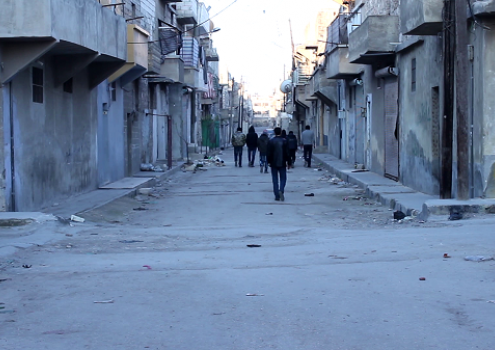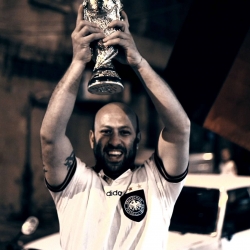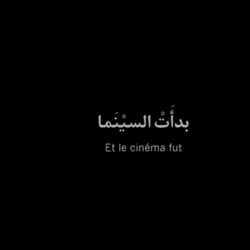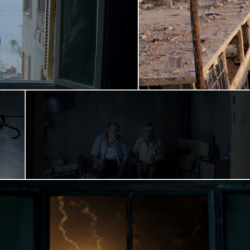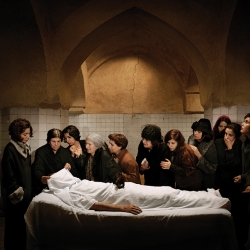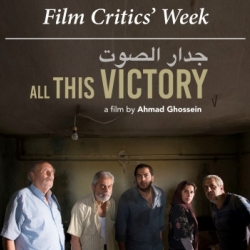31/01/2017
Author: Orwa Al Mokdad
The horizon splits the frame, a third of which unfolds destroyed cement buildings and then merges into the ruins. In the remaining two-thirds, purple-tinted clouds sink in the buildings immersed in black. The frame follows a path that leads to the destroyed buildings. From the depth of the ruins, a woman emerges. She’s wearing a black coat and a patterned veil and holding a bouquet of chrysanthemums. In slow steps, she proceeds to place the bouquet on a mound of ruins. She turns to the frame and says: The war is over.
It’s holiday. The ads of the film fill up the streets with warm colors. A couple in their fifties hold hands at the cinema entrance. Faces are serene and joyful. Animated discussions bring friendliness to the place. Despite its destruction, the city is lively again. In the theater, faces react to the reflections of the big screen. Gasps and smiles. The film’s final scene: the woman walks toward the ruins. She places a bouquet of chrysanthemums. She then turns and says: The war is over. At this moment, viewers will tear up. I, too, wipe my tears. The film ends.
If I could end my film this way, I would. I would like to make a romantic film, a traditional love story, one that enchants viewers. A story about how a heroine rescues her lover and declares the war over. As I walk through the ruins, I think: creating a “war location” is not that hard, but just costly production-wise. My dream is to make a fiction film. When I shot my documentary 300 Miles, I tried to create fictional characters to give viewers the impression that they were watching a fiction film. Fiction films are more convincing and everlasting. In them, viewers inhabit the characters of the heroes, sharing every detail of their lives. But I do not have that luxury. Death is the only hero and we are characters in a film that has yet to end.
I’m intrigued by the edge of a broken mirror. I pick it up and try to glance at my own features. In mirrors, time comes to a halt. Suspended. On the other side, they use destroyed buildings as locations to make fiction films. Since the revolution began, the regime took pleasure in the practice of killing. Now, there’s pleasure in filming killing, the pleasure that stems from deliberately creating a work of art; filming in the midst of the ruins, on top of the tanks, protected by jets. There are hoards of actors and technicians driven by this pleasure—the appetite of a cold killer. On holidays, there, on the other side, there are people flocking to theaters to watch the spectacle that is our death. This type of cinema has perhaps earned its label: Cinema of Death.
I take anxious steps. I rest my shoulder on the wall and then look at the corpse whose head was penetrated by a shrapnel. I turn the camera and spontaneously determine the width of the shot. The material realm merges with that of the screen. I think of the realm that the corpse occupies. There is another realm, another dimension to the persistence of the shot in the mind as it moves to the subconscious. I will have to reposition the corpse so it can be more convincing. I drag it down. Half of it appears in a tilting corner in the frame: The eyes are swollen, the cheeks sore, the face half-charred. I turn the corpse to its edge. I move the field of vision so that the corpse is curled up in a fetal position. I will give the character a romantic monologue. It will not concede its death so that it relieves others from guilt. It will say: I committed suicide because I couldn’t bear the sound of the ticking clock.
I will design the scene once more, because the audience needs stormy violent drama:
The jet approaches. The sky is wide, filled with purple-tinted grey clouds. The jet is invisible. Its sound reverberates everywhere. Different age groups animate the scene: children, women, the elderly. Features are insignificant. Panic is a minor and harmful detail. The pilot is unknown. The origin of the barrel is unknown. All of these are superfluous pieces of information that are insignificant to the scene. What characters utter before they die is insignificant. We only hear what sounds like agitation. Action! Napalm inflames the cement then explodes and burns all bodies. Limbs are scattered everywhere. The scene is like any other from war movies: minor and insignificant. Perhaps the only hero in this entire film is Bashar al-Assad.
People go to dark rooms, cinemas. They stay at home at the end of the day not to change the world, but rather to unwind and be entertained. How is it possible, then, to make films about war, films that aim to shock viewers enough so they change the world? In Cinema: The Time-Image, Gilles Deleuze writes: “Everyone knows that, if an art necessarily imposed the shock or vibration, the world would have changed long ago. So this pretension of the cinema, at least among the greatest pioneers, raises a smile today. They believed that cinema was capable of imposing the shock, and imposing it on the masses, the people (Vertov, Eisenstein, Gance, Elie Faure...)”.
Cinema, then, will not trigger the shock we have anticipated, the shock triggered by the depiction of killing and repression, and subsequently the details of the war that the regime has waged. On the other side, when filmmakers turn their camera in order to shoot a film about the “entertaining” war, they don’t have to shock their viewers. They just have to convince them to stay at home or leave at the end of the film, unfazed.
So why, then, do we make films about our death? To entertain others?
When I filmed scenes for 300 Miles, I avoided shots of corpses and death. I was trying to search for faces that mime silently, and in so doing inspire meditation about the thickness of time that people experience under siege and bombs. I was wondering how it is possible that the delusion of people who go to the cinema to experience the pleasure of inhabiting other lives is not repulsive; how it is possible for pain to turn into pleasure, one that pushes viewers to interact with and inhabit the lives of characters, so that they believe that death is not only that which is “real”, but rather, a harsher kind, that which we observe without being able to change.
Four years after it was shot it in a destroyed city, 300 Miles was shown in cinemas across the world. I was waiting to hear about the shock that will transform the course of the war—the naïveté of my first experience in making my first film. Later, I watched the film in a small cinema in Beirut. Watching it, I wondered as any other viewer would: Why would people watch a film that does not entertain? Why would people watch a film that is only about death that is real?
Looking at the screen, I thought of all our years in Syria. The regime had robbed us of the pleasure of appreciating life’s wonders, and later of the pleasure of discovery and spectacle that turn cinema and art into a medium for entertainment and leisure. In this part of the world, we experience cinema through death. We learn about its tools by sensing our rebirth outside the structure of death, terror, and annihilation that we have experienced in the last fifty years; death with which we clash daily so we can learn about life. The sole topics to which we have gravitated in the last five years are death and burying the dead. As such, filming and the desire to make films have become wooden weapons in the hands of quixotic characters fighting the invisible windmills of the world that we are not quite able to confront. It’s no longer about high-tech cinema, but rather about an arbitrary and rough battle in which cannons and barrels perforate our daily lives.
On the other hand, we, Syrians, seem like fictional characters in a spectacle that aims to entertain; in a romantic film that drives people to gasp and be moved by the power of heroes as they face the forces of evil. Later, viewers will curse and despise the evil ones and head home to resume their daily lives. The film ends when entertainment is no more.
This article was translated from Arabic, click here for the Arabic text.



